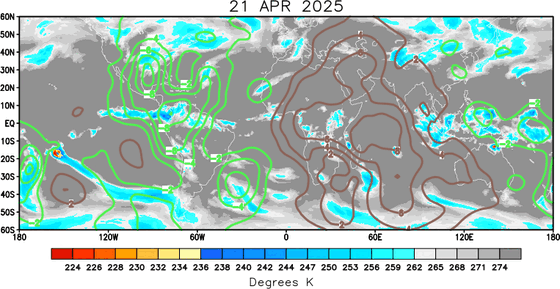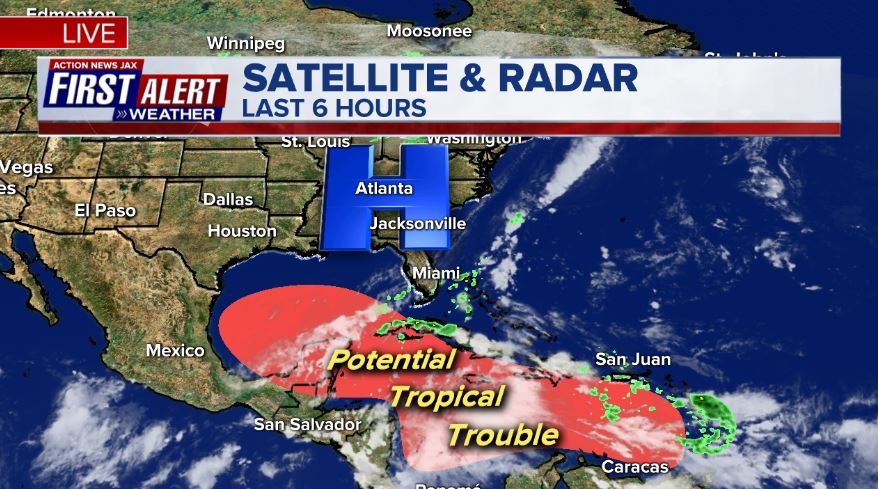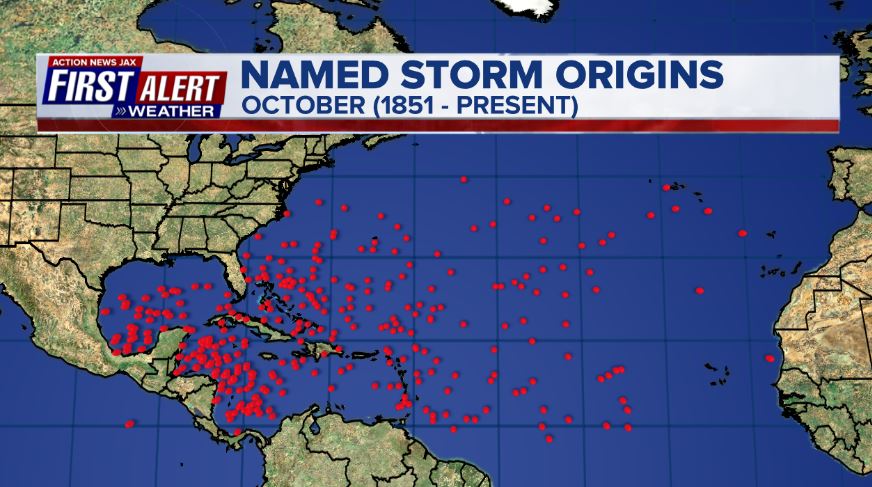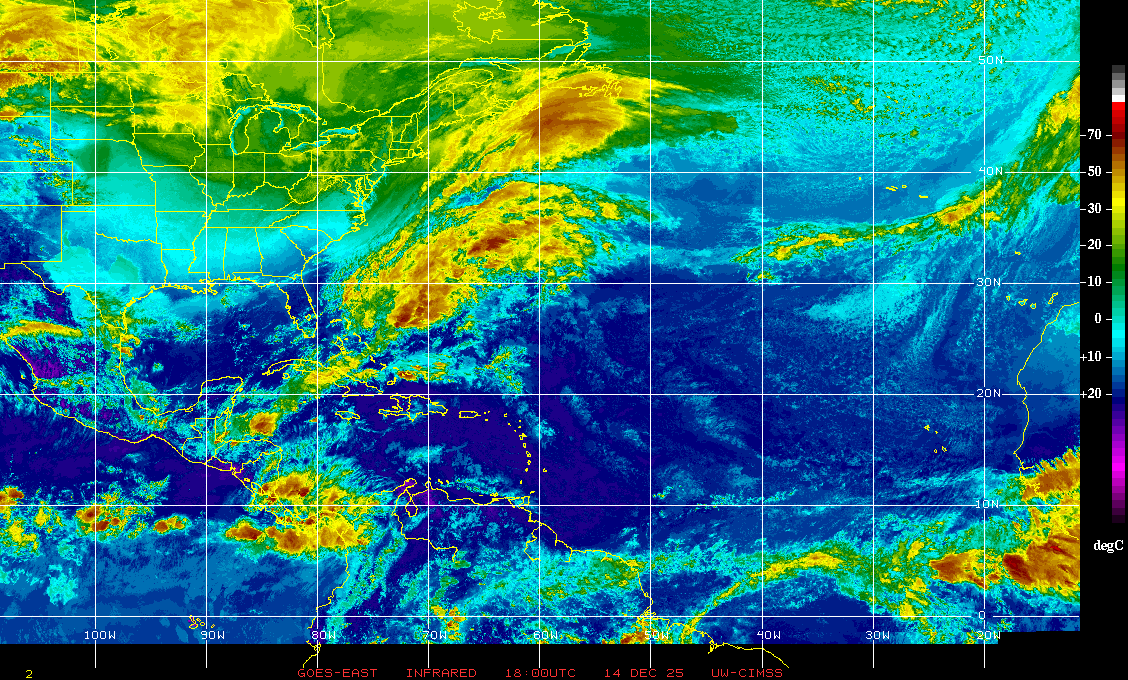Jacksonville, Fl. — The “Buresh Bottom Line”: Always be prepared!.....First Alert Hurricane Survival Guide... City of Jacksonville Preparedness Guide... Georgia Hurricane Guide.
STAY INFORMED: Get the * FREE * First Alert Weather app
FREE NEWS UPDATES, ALERTS: Action News Jax app for Apple | For Android
WATCH “Talking & Tracking the Tropics: The Science Behind the Season”
WATCH “Preparing for the Storm”
READ the First Alert Hurricane Center “Survival Guide”
***** ALWAYS CHECK & RE-CHECK THE LATEST FORECAST & UPDATES! *****
-- THERE WILL BE *NO DIRECT* IMPACTS FROM TROPICAL SYSTEMS FOR JACKSONVILLE/NE FL./SE GA. THROUGH AT LEAST THE MIDDLE OF THE WEEK. ANY DIRECT IMPACTS FROM “DELTA” LOOK TO STAY WELL WEST OF JACKSOVILLE....
Overall... the Caribbean & Gulf of Mexico continue to be areas to watch for at least the next couple weeks... along with nearby areas of the SW Atlantic. If traveling anytime soon to any areas susceptible to tropical systems - especially the Gulf Coast & NW Caribbean, stay up to date on the latest, updated forecast......
A Caribbean tropical wave was upgraded to tropical depression #26 Sun. night... to tropical storm “Delta” early Monday then to a hurricane Monday evening while moving west/NW across the Caribbean a little south & southwest of Jamaica. Like has happened so often this season, this is the fastest ever to the 25th storm beating by more than a month the previous record of Nov. 15th, 2005. Models had been wildly inconsistent amongst themselves not to mention compared to one another until starting to smooth out later Sunday followed by remarkable agreement through most of Mon. The west/northwest movement will become more northwest through mid week then turning more north, even northeast late in the week as a new upper level trough digs into the Lower 48 weakening the upper level ridge across the Northern Gulf. This upper level trough - timing, orientation & strength - will be a major player on where the tropical cyclone (Delta) goes & how strong it might be. Given recent trends & typical model biases, it seems a more westward position for a longer period of time might be the way to go which would put Delta close to the Yucatan Peninsula or even Belize before turning more northward. Any land interaction could interrupt intensification Wed. before “cleanly” moving over the Gulf of Mexico but Delta’s swift movement will likely limit its time over land. Models have also generally slowed movement over the Gulf bringing Delta ashore Fri. afternoon or even Fri. night. If the center does come inland west of New Orleans, there will be a good deal of storm surge pushed into New Orleans.
Currently there’s lots of shear over the Gulf of Mexico on the order of 30+ mph that only becomes stronger the more north over the Gulf. This shear will essentially remain in place for the next few days before lessening by the weekend/the following week. There is also nearby dry mid & upper level air. This combination rapidly weakened Gamma but by the time Delta is into the Northern Gulf, the shear should be relaxing some & will also be in the direction from which Delta is moving which may mean a little less impact on the storm. However, ocean temps. will not be as warm as the Caribbean/far Southern Gulf. In the short term - through early Wed. - Delta should be able to take advantage of nearly ideal conditions - low shear/very warm ocean temps. - to steadily - at times - rapidly intensify.
A word of caution!: the models have struggled with the pattern recently & the upper level steering currents will be evolving considerably in the coming days thanks to the “new” trough moving into the U.S. The trough will have a big impact on the exact landfall point along the Gulf Coast.
“Bath water” - NW Caribbean:
Meanwhile.... Tropical depression #25 formed over the Western Caribbean Fri. morning & strengthened into tropical storm “Gamma” Fri. evening & would have reached hurricane strength Sat. had it not been for landfall on the Yucatan Peninsula about 1pm EDT. It’s the fastest ever to the 24th tropical storm of the season beating the record of Oct. 27, 2005.
The combination of a tropical wave, lower pressures & an old front developed low pressure at the surface over the far Western Caribbean which was upgraded Fri. to t.d. #25 then tropical storm Gamma Fri. evening then back to a tropical depression late Mon. The GFS model has been superior so far indicating a more northward move over the weekend. Most models now seem to be catching on. Despite the northward move into the warm water of the far Southern Gulf, Gamma is now dominated by high shear that will not change much in the coming days. The shear (out of the southwest) quite literally decapitated Gamma & the system is drifting to the southwest & should dissipate soon.
As I mentioned last week, dominant high pressure across northern latitudes this time of year often does yield tropical trouble that begins in or near the Caribbean. Personally I would be surprised if there was not at least one Cat. 3+ hurricane that develops out of this pattern even though the forecast models are not indicating such for the moment. I don’t type this to try to “cry wolf” - it’s my job to forecast. Hopefully whatever does develop does not end being a major landfalling storm. In any case... stay tuned!
Other tropical waves farther east will have a hard time making it all the way across the Atlantic & will be encountering increasing shear - typical later in the season.




Water vapor imagery clearly shows the dry mid & upper level air across the NW Gulf as well as the far NW Caribbean. Forecast models show the dry air gradually peeling away from Delta so as to not have a major impact in the hurricane, but it is something to watch....






Persistent, broad & strong high pressure at northern latitudes helping to induce low pressure at lower latitudes:
Through at least mid month.... vertical velocities look to become more favorable across the Atlantic Basin Oct. 10-20 - “ish”. “Velocity Potential Anomalies” show a good deal of sinking air (brown lines) right now but more favorable rising air (green lines) should push east from the Pacific in due time which does match a climatological 2nd peak of sorts (Oct. 15-20) for Atlantic tropical development.

October tropical cyclone origin points are clustered over the Caribbean, Gulf of Mexico & SW Atlantic:
Atlantic Basin wave forecast for 24, 48 & 72 hours respectively (major wave action at Fl./Ga. beaches through early next week due to persistent brisk onshore flow (high pressure to the north) combined with easterly swells from distant Teddy:








:quality(70)/cloudfront-us-east-1.images.arcpublishing.com/cmg/WW5AJL3ARQUGDQMAQUNSFX4CLE.jpg)






















:quality(70)/d1hfln2sfez66z.cloudfront.net/04-22-2024/t_798f1ca740b74dceb180b6927df8b0f7_name_file_960x540_1200_v3_1_.jpg)
:quality(70)/cloudfront-us-east-1.images.arcpublishing.com/cmg/WJVERMTCKFHFPBF2LNONHSDB4M.jpg)
:quality(70)/d1hfln2sfez66z.cloudfront.net/01-16-2023/t_1f852e6223cd4a1495e39af4b9acb7f1_name_file_960x540_1200_v3_1_.jpg)
:quality(70)/d1hfln2sfez66z.cloudfront.net/04-16-2024/t_df20ecc7bd6a4ec69132a4173b162c6e_name_file_960x540_1200_v3_1_.jpg)
:quality(70)/cloudfront-us-east-1.images.arcpublishing.com/cmg/3626MAF7ZFHEZBT6OGRVB5QUF4.jpg)